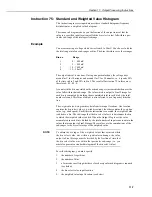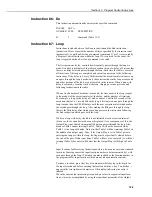
Section 12. Program Control Instructions
12-9
the command in the If Case instruction is executed and the program flow goes to
the End instruction associated with the Begin Case instruction.
PARAM.
DATA
NUMBER TYPE
DESCRIPTION
01:
4
Input location for subsequent comparisons
Example
01:
P93
Case
01:
2
Case Loc
02:
P83
If Case Location < F
01:
69.4
F
02:
3
Call Subroutine 3
else
03:
P83
If Case Location < F
01:
72
F
02:
10
Set high Flag 0 (output)
else
04:
P83
If Case Location < F
01:
77.3
F
02:
30
Then Do
05:
P30
Z=F
01:
0
F
02:
0
Exponent of 10
03:
25
Z [Loc:
]
06:
P95
End
Then Do
07:
P95
End
of Case Statement
Instruction 94: Else
When command 30 (Then/Else) is used with an If instruction, the Else instruction
is used to mark the start of the instructions to execute if the test condition is false.
The Else instruction is optional; when it is omitted, a false comparison results in
execution branching directly to the End instruction. Instruction 94 has no
parameters.
Instruction 95: End
Instruction 95 is used to indicate the end/return of a subroutine (Instruction 85),
the end of a loop (Instruction 87), the end of an ‘If Then/Else’ sequence
(Instructions 88-92 when used with command 30), or the end of a Case sequence
(Instruction 93). The End instruction has no parameters.
Instruction 96: Activate Serial Data Output
Instruction 96 is used to activate Storage Module, Card Storage Module or serial
data (printer) output. Normally Instruction 96 is placed in the program table after
all Output Instructions have been entered and is executed each time the table is
executed. In this situation any data sent to Final Storage is output as soon as
possible. However, by using Program Control Instructions to allow execution of
Instruction 96 only at certain times, you can control when the output device(s) are
active. Instruction 96 allows a choice of serial data formats and the selection of
Addressed or Pin-Enabled devices for the serial print output.
















































